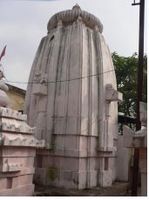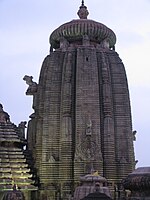
Jagannath is a deity worshipped in regional Hindu traditions in India and Bangladesh as part of a triad along with his brother Balabhadra and sister, devi Subhadra. Jagannath within Odia Hinduism is the supreme god, Purushottama, Para Brahman. To most Vaishnava Hindus, particularly the Krishnaites, Jagannath is an abstract representation of Krishna, and Mahavishnu, sometimes as the avatar of Krishna or Vishnu. To some Shaiva and Shakta Hindus, he is a symmetry-filled tantric form of Bhairava, a fierce manifestation of Shiva associated with annihilation.

Baripada is a city and a municipality in Mayurbhanj district in the state of Odisha, India. Located along the east bank of the Budhabalanga river, Baripada is the cultural centre of north Odisha. In recent years, it has emerged as an educational hub with the opening of numerous professional colleges.
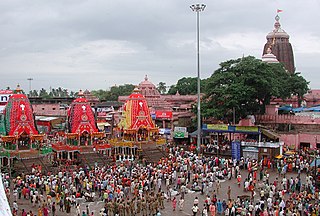
Ratha Yatra is a Hindu festival associated with Lord Jagannath held at Shri Khetra Puri Dham in the state of Odisha, India. It is the oldest Ratha Yatra, whose descriptions can be found in Brahma Purana, Padma Purana, and Skanda Purana and Kapila Samhita. Rath Yatra or Jatra is the celebration of the Lord Jagannath, who is believed to be the Lord of Universe's journey towards his aunt's house.

Lingaraja Temple is a Hindu temple dedicated to Shiva and is one of the oldest temples in Bhubaneswar, the capital of the Indian state of Odisha,India. The temple is the most prominent landmark of Bhubaneswar city and one of the major tourist attractions of the state.
Tourism in Odisha is one of the main contributors to the Economy of Odisha, India, with a 500 km (310 mi) long coastline, mountains, lakes, natural biodiversity and rivers. Odisha is one of the major tourism sectors of India, with various tourists' attractions, ranging from wildlife reserves, beaches, temples, monuments, the arts and festivals. Other than wildlife reserves, beaches, temples, monuments, the arts and festivals, the Odisha Tourism Development Corporation, a Public Sector Undertaking of Government of Odisha, is also developing tourism sector of Odisha and India.

Rajarani Temple is an 11th-century Hindu temple located in Bhubaneswar, the capital city of Odisha, India.

Aisanyesvara Siva Temple is a 13th-century Hindu temple dedicated to Shiva located in Bhubaneswar, the capital of Odisha, India. The temple is in the precinct of Municipal Corporation Hospital, Sriram Nagar, Old Town, Bhubaneswar. It is close to the western compound wall of Lingaraj Temple. This is a living temple and with a shrine facing east.
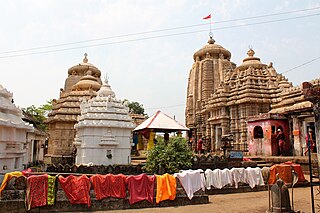
The Kapilesvara temple is a Hindu temple dedicated to Shiva located in the south western outskirt of the village Kapilesvara, Old Town, Bhubaneswar, Odisha, India. It is located at the end of Kapilesvara road leading from Lingaraj temple to Kapilesvara Village. The presiding deity is a Siva-lingam at the center of a circular yonipitha inside the sanctum. It is a living temple, facing towards east and maintained by Kapilesvara Temple Trust Board. The temple is situated within the precinct along with 33 other monuments. The precinct is located on the northern embankment of Manikarnika tank over an area of 44.00 square metres.

Lokanatha Siva Temple also Amunha Deula is an 11th-century AD temple in Bhubaneswar in the state of Odisha, India. It represents a proto type of Lingaraja in a miniature form. Lokanatha Siva temple is located in front of the Lingaraja temple in the south eastern corner across the road and adjacent to Lingaraja Temple Police Station in Old Town, Bhubaneswar. Until 1972 the temple was buried from all sides up to the bandhana portion, giving an impression as if the temple had no entrance. Hence people called it Amuha deula. In 1972 Debala Mitra conducted an excavation in front of the northern wall and exposed the entrance. The sanctum was empty. However, on the basis of the local traditions and the sculptural embellishment on the outer wall it was ascribed to Lord Siva. It is now known both as Lokanatha Siva and Amuha deula. People ascribe the temple to the Kesharis (Somavamsis). Except the entrance all other sides it is buried up to the bandhana.

Bharati Matha Temple is a temple of the Hindu God Siva in Bhubaneswar, Orissa, India, The temple is a Hindu monastery with three stories which was built in the 11th century AD. It is currently used for living Matha purposes and earlier it was used as a Hindu pilgrimage centre.
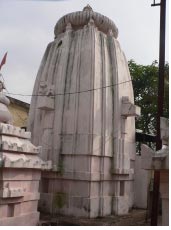
Isanesvara Siva Temple is a 13th-century ad temple in Bhubaneswar in the state of Orissa, India. The time period of its construction is estimated from its architectural features and it is suggests the temple to ganga period. Isanesvara Siva temple is in the Goasagaresvartemple precinct, on the left side of Ratha road old Town, Bhubaneswar. It is one kilometre (0.62 mi) west of Lingaraja Temple and one km south of Ananta Vasudev, 300 m (980 ft) southwest of Ramesvara temple and 200 m (660 ft) northwest of Baitala Deula. The temple is facing towards east. The presiding deity is only a circular yon pitha. The lingam is missing.
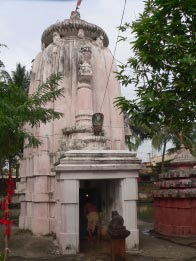
Paradaresvara Siva Temple is a 13th-century AD temple in Bhubaneswar, Odisha. The time period of its construction is estimated from its architectural features and it suggests that the temple must belong to the ganga period. Paradaresvra Siva temple is situated in the Gosagaresvar temple precinct. It is located on the left side of Ratha road old town, Bhubaneswar. It is located at a distance of 1 km west of Lingaraja Temple and 1 km south of Ananta Vasudev, 300 metres southwest of Ramesvara Temple and 200 metres northwest of Vaital Temple. The temple is facing towards east. The presiding deity is only a circular yonipitha in the cella that measures 3 square metres. The lingam is missing.

Shri Shri Hari Baladev Jew Bije is a famous Hindu temple located in Baripada, Mayurbhanj district, in the state of Odisha, India. The name Jagannath is a combination of the Sanskrit words Jagat (Universe) and Nath.
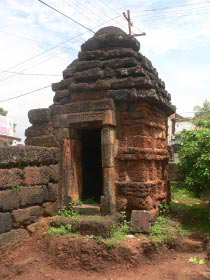
Papanasini Siva Temple is an abandoned Hindu temple located in Bhubaneswar, Orissa, India.

Sukutesvara Temple located in the old town of bhubaneswar,Odisha,India,serves as purpose for community gathering. The preceding deity in this temple is a Siva- lingam situated at the centre. The temple observes various religious sacraments like Mahasivaratri, Chandipatha and Rudrabhisekha.

Bata Mahadeva is a Hindu temple, dedicate to Lord Shiva. This is one of the oldest temple in Bhubaneswar, a well known heritage place and capital of Odisha.

Sivatirtha Matha a Hindu Matha (monastery) in the outskirts of old town of Bhubaneswar, Odisha, India, and is known for Chandan Yatra and Dola purnima. Dola Purnima is celebrated in the belief that Lord Lingaraja arrives to this Matha to take pankti bhogo on Dola Purnima.

In Hindu temple architecture, ratha is a facet or vertical offset projection on the plan of the sanctum and shikhara above, or other structure. The term has the same meaning when applied to the forms of the bases of statues.

Deula is an architectural element in a Hindu temple in the Kalinga architecture style of the Odishan temples in Eastern India. Sometimes the whole temple is also referred to as Deula. The word "deula" in Odia language means a building structure built with a particular style that is seen in most of the temples from Odisha. Deul is also used in English, though the deul temples are also of a different form in the Manbhum region of Western Bengal.

Ratha Yatra, or Chariot festival, is any public procession in a chariot. The term particularly refers to the annual Ratha Yatra in Odisha, Jharkhand, West Bengal and other East Indian states, particularly the Odia festival that involve a public procession with a chariot with deities Jagannath, Balabhadra, Subhadra and Sudarshana Chakra on a ratha, a wooden deula-shaped chariot. Ratha Yatra processions have been historically common in Vishnu-related traditions in Hinduism across India, in Shiva-related traditions, saints and goddesses in Nepal, with Tirthankaras in Jainism, as well as tribal folk religions found in the eastern states of India. Notable Ratha Yatras in India include the Ratha Yatra of Puri, the Dhamrai Ratha Yatra and the Ratha Yatra of Mahesh. Hindu communities outside India, such as in Singapore, celebrate Ratha Yatra such as those associated with Jagannath, Krishna, Shiva and Mariamman. According to Knut Jacobsen, a Ratha Yatra has religious origins and meaning, but the events have a major community heritage, social sharing and cultural significance to the organizers and participants.


